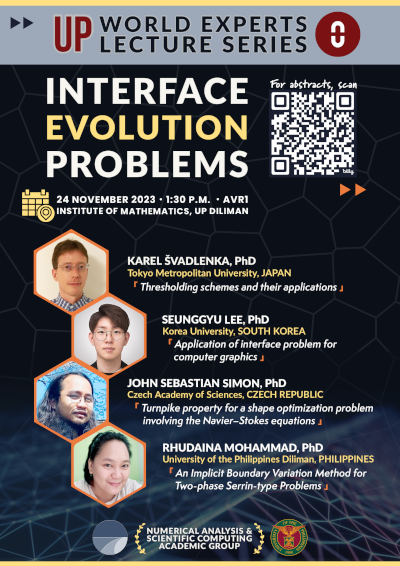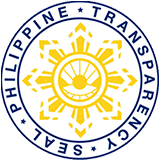UP World Expert Lecture Series: Karel Švadlenka, Ph.D., Seunggyu Lee, Ph.D., John Sebastian Simon, Ph.D. and Rhudaina Mohammad, Ph.D.

You are all invited to attend the UP World Expert Lecture Series hosted by the Institute of Mathematics on Friday, November 24, 2023, 1:30 – 5:20 PM. This is an in-person event and it will be held at MBAN AVR1. More information can be found here.
Plenary Talks:
Karel Švadlenka, Ph.D. (Tokyo Metropolitan University, Japan)
Title: Thresholding schemes and their applications
Abstract: In this talk, I will first briefly introduce a convenient method to approximate interface evolution, called thresholding method or diffusion-generated motion or the BMO algorithm. Then I explain its mathematical background rooted in the notion of minimizing movements, which in turn allows for extension of the idea to more complicated problems, such as motion of interfacial networks with differing surface tensions or orientation-dependent evolutions. In the end, I will show two interesting applications to two rather complex phenomena: cellular patterning during morphogenesis of epithelia in sensory organs and evolution of anisotropic particles on substrate.
Seunggyu Lee, Ph.D. (Division of Applied Mathematical Sciences, Korea University, South Korea)
Title: Application of interface problem for computer graphics
Abstract: The interface problem is widely applied to various fields not only in mathematics but also science, engineering, and other related topics. In this lecture, we briefly understand how to derive the basic equations of the motion under the physical point of view with visualization by executing the MATLAB (or Octave) code in a step-by-step manner with simple examples: the advection and diffusion equations, which are one of the most simple but powerful equations describing dynamic motions, are coupled with the interface representing methods.
Invited Talks:
John Sebastian Simon, Ph.D. (Czech Academy of Sciences, Czech Republic)
Title: Turnpike property for a shape optimization problem involving Navier-Stokes equations
Abstract: In 1994, J. Huan and V. Modi postulated that solutions of shape design problems for the time-dependent incompressible Navier–Stokes equations can be approximated by the solution of the same problem, but involves the stationary equations. The authors backed this theory by explaining that the time derivative vanishes when numerically solving the Navier–Stokes equations. Perhaps, this is also the reason why most shape optimization problems dealing with fluids are posed with the stationary equations. However, as far as we are aware, there is no rigorous proof establishing such conjecture. In this talk, we provide such proof by employing basic functional analysis tools. We will prove a relaxed version of the turnpike property, i.e., we show that the solutions of the time-dependent shape optimization problem behave asymptotically towards the solution of the stationary problem. The convergence of domains is based on the L∞-topology of their corresponding characteristic functions which is closed under the set of domains satisfying the cone property. Lastly, a numerical example is provided to show the occurrence of such convergence.
Rhudaina Mohammad, Ph.D. (Institute of Mathematics, University of the Philippines Diliman)
Title: An Implicit Boundary Variation Method for Two-phase Serrin-type Problems
Abstract: A classical result by Serrin asserts that if the Poisson equation subject to both Dirichlet and Neumann boundary conditions, under certain regularity, admits a solution, then the domain must be a ball. Considering a two-phase Serrin-type overdetermined problem with respect to an operator in divergence form with piecewise constant coefficients, Cavallina and Yachimura showed that if the core is sufficiently close to a ball, then the domain must also be sufficiently close to a ball. Such problems appear as shape optimization of coated materials and optimal design of bi-material structures. In this work, we develop a numerical method based on the Osher-Sethian level set formulation of the (explicit) boundary variation algorithm for shape optimization. We employed a descent method using the shape gradient of a Kohn-Vogelius functional while imposing volume constraint by a quadratic penalty method. The implicit nature of this method eliminates the need for ad hoc algorithms to handle mesh-related issues. Finally, we present some numerical examples of one-phase and two-phase problems.
